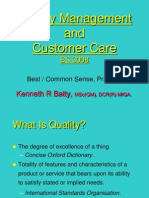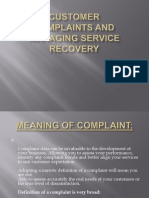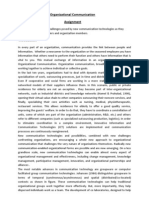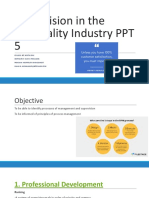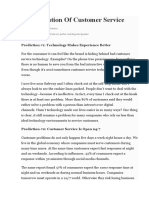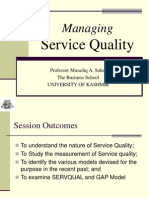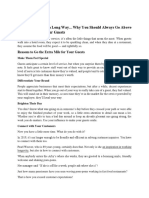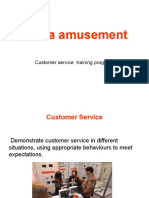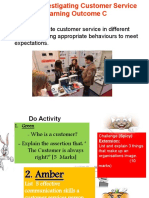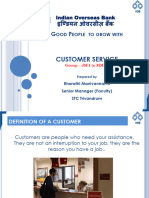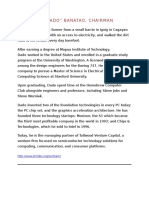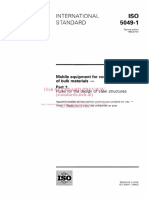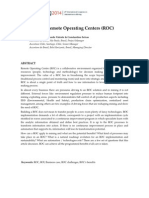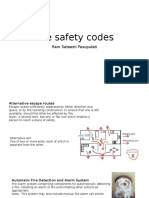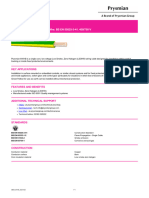Customer Service
2006
�Objectives
Today we will learn how to
Communicate effectively with customers
Create a positive impression
Develop and maintain customer service
standards
Plan good customer service
�Who are Customers?
Definition of a customer
Internal/external customers
Customers are people who need your assistance.
They are not an interruption to your job, they are
the reason you have a job..
Explain that there are external and internal customers: People who phone,
People who walk-in, People who write
People from within your organisation, People from other organisations, Media,
Students
�Communicating Effectively with Customers
Definition:
What describes GOOD service and BAD service?
Good customer service is taking that extra step to
help without being asked! Its all about attitude
and skills.
10 minutes- With the person next to you, talk about when youve had good service and when
youve had bad service. Make a list of aspects of each.
�Attitude Checklist
What attitudes assist in providing good service?
Enjoy helping people
Handle people well
Care for your customers
Give fair and equal treatment to all
Be understanding of people with special needs
Mention well talk about special needs later.
�Skills for Customer Service
Know about your organisation
Learn the technical parts of the job
Communicate well
Be consistent
Be organised
Know your place in the team and be a team
player
Emphasize the importance of training, duty statements, orientation, policy and
procedures manuals
�What do Customers Want?
Brainstorm what it is that a customer wants when
they enter your organisations
Discuss and share with the group
From the activity good/bad service, identify the kinds of things customers want.
�Greeting Customers
The purpose is to create and maintain a welcoming
environment - how can we achieve this?
Be attentive, acknowledge a person as soon as they appear,
even if youre busy
SMILE!
Establish eye contact
Tell them your name
Ask how you can help
Give the customer your full attention
Be polite and courteous
Make notes on GOOD GREETING BEHAVIOUR
�Establishing Rapport
What does good rapport feel like?
Practice greeting someone
Make the customer feel comfortable
Make the customer feel important and valued
Use empathy
Role play
�Find out how You can Help
How can you find out what people want?
If you cant help, what should you do?
Offer alternatives if possible
If they have to wait, how would you handle it?
10
�Communication is a 2-way Process
Communication skills involve:
Listening to others (Receiving)
Asserting/ Expressing (Sending)
sender
message
receiver
sender
Barriers
receiver
These 4 slides present theoretical ideas in graphic form. They have been used in
other workshops (Effective Communication and Frail Aged) and can be glossed
over quickly if people are familiar with the concepts and how they impact on
practice in the workplace.
11
�The Communication Equation
What you hear
Tone of voice
Vocal clarity
Verbal expressiveness
What you see
40% of the message
or feel
Facial expression
Dress and grooming
Posture/ Body Language
Eye contact
Touch
Gesture
WORDS..
50% of the message
ONLY 10% of the message!
12
�Effective Communication Skills
Eye contact & visible mouth
Body language
Some questions
Encouragement
to continue
Summarising
what has been said
Effective
Communication skills
silence
Checking for understanding
Smiling face
13
�Barriers to Effective Communication
Language
Noise
Time
Distractions
Other people
Too many
Questions
Put downs
Barriers to
effective communication
Distance
Lack of interest
Disability
Discomfort
with the topic
14
�How to Listen to Customers
Active listening = Attending skills (being ready)
Attend to immediate needs (if you need to finish
something before giving your full attention)
Being available
Eye contact
Attentive posture
Concentration
15
�Following Skills
This opens the door to further communication
Invitations
Questions
Encouragement
Empathetic Silence
16
�Questioning Skills
Open Questions
Closed Questions
Paraphrasing
Check for
Understanding
Activity to practise questioning based on Simple questions sheet and
Paraphrasing sheet. Notes to be written in workbook by participants.
17
�Reflective Skills
Keeps the door open for further communication
Paraphrasing
Reflecting Facts
Reflecting Feelings
Reflecting Silence
Summarising
Choosing your Words
Useful Phrases
18
�Using Your Voice
Do you
Become loud when angry or upset
Speak faster when nervous
Speak slowly when tired or bored
Have a cheerful voice
My tone of voice is warm and understanding
Find it easy to talk to people you dont know
Control your tone in most situations
Sound bossy, weak or unsure
Have a clear and easy-to-hear voice
Speak in a very formal or very trendy manner?
Think about how you might modify your voice in certain
situations
Let people read through the list and think about how they use their voice in
different situations.
Go around the room and make sure each person gets a chance to have a go.
Ask a participant to say Jonathon your tea is getting cold; Kim I need your
help. Maxine there are three items missing from this set. Each person must
say it in a different way to the person before.
19
�Body Language for a Positive Result
Brainstorm some examples of good body language
Smile
Introduce yourself (if appropriate) or wear a name
badge
Shake hands if appropriate
Lean forward
Be aware of cultural differences
Ask group for examples of cultural differences.
20
�Telephone Skills
Know how to use the phones
Speak clearly and slowly
Smile (you can hear it in your voice!)
State your name and organisation
Write down the callers name and use it
Dont say rude things while someones on hold
If theyre explaining something use words to show
youre listening (umm, yes )
Have pad and pencil ready to take notes or messages
(check spelling and message content)
Dont eat or drink while on the phone
21
�Written Communication
Write clearly and concisely
Refer to their letter, date and query
Be friendly without being too informal (Dear Aunt
writing style)
Check your spelling and grammar
Make sure youve answered their query or request
or explained why you cant
Be timely or apologise for any delay in replying
Dear Aunt letters dont write in an officious way. Write as you would to an aunt.
22
�Guaranteeing Return Business
Leave a positive impression, smile
Check customers have everything they need
If youve said youll follow-up, do so
Tell them something that may be useful to them later
(eg new service starting soon)
Invite them back
Say goodbye
What makes you go back to a place?
23
�A Positive Organisational Image
First impressions count and will affect the interaction. People make
judgements in the first 30 seconds.
Golden Rule You only have one chance to
make a first impression!
24
�Organisational Assessment - Activity
Take a look at your organisation through the eyes of a customer.
What are the first things you notice?
What has the organisation done to make you feel welcome?
Does anything make you feel uncomfortable?
How could you feel more at ease?
Form small groups and discuss different methods used to
help people feel welcome.
One person from each group to present back.
Allow around 10 minutes for group discussion and 5 minutes to report back
25
�Presentation and Manner
Does your Organisation have a policy on presentation?
Uniforms, badges, etc
Personal hygiene
Clothing appropriate to the situation
Hair cleanliness and style
Accessories jewellery, earrings, watches, tattoos,
Expression facial expressions
Tone of voice
Body language
Surroundings (Can they see a messy desk? Dead flowers in the
vase? Eating your lunch?...)
26
�A Positive First Impression
Be confident
Knowledge - know your organisation and the services
you provide
Confidentiality
Follow up (dont just say youll do something, do it)
Strengthen the customers commitment to your
organisation
27
�What to Avoid
Saying I dont know without offering an option
Saying you dont know where a colleague is or saying
theyre at lunch/ toilet/ gone for coffee etc
Leaving people on hold for a long time
Ignoring people if youre busy
Treating people unequally
How else can you say I dont know? Ill find out for you, Ill need to check on
that and get back to you, Ill have to look that up, when is a good time for me to
call you back?
28
�Service Standards
How can you contribute to the development and
maintenance of service standards in your volunteering
organisation?
Read and understand your organisations policies and procedures
on customer service
Be prompt and efficient
Ensure services are delivered in accordance with legislative or
statutory requirements
Maintain accurate records
Ensure any special needs of customers are taken into account
29
�Factors Affecting the Quality of Service
Reliability
Confidence
Responsiveness
Efficiency
Consistency
Organisation
Acceptance of and adherence to policies and
procedures
30
�Customers with Special Needs
People for whom English is not their first language
People with disabilities
People from other areas who may not be familiar with
the way things are done here
People with limited mobility
Unaccompanied children
Discuss techniques for dealing with these situations visually impaired, hearing
impaired, wheelchairs, translators etc. Dont make assumptions.
31
�Planning Good Customer Service
Recording procedures (when are your busy times)
Reporting procedures (meeting organisational/ funding/
legislative requirements)
Observe and report customer needs
Be proactive in improving service
Market your organisation
Have processes and procedures for dealing with difficult
situations BEFORE they happen and make sure staff are
trained.
32
�Dealing with Difficult Behaviour
Label the behaviour, not the customer
Listen
Dont get defensive
Dont take it personally
Find out what the customer wants
Discuss alternatives
Take responsibility for what you CAN do
Agree on action
33
�The Talkative Customer
Ask closed questions
Limit the time available for them to interrupt (dont have
long pauses)
Provide minimal response
Smile and be pleasant, but dont encourage them
Wind up thank them for coming, walk them to the door
but dont be rude or dismissive
34
�The Angry Customer
Listen carefully without interrupting so you understand
the problem
Empathise in a broad way
Stay calm and remain polite
Dont escalate the problem
Dont take it personally, be defensive or blame others
Propose an action plan and follow it
Seek support if you are scared, if you cant agree on a
solution or if the customer asks to see whoevers in
charge
35
�The know it all Customer
Acknowledge what they say
Compliment them on their research
Be generous with praise
Dont put them in their place no matter how tempting
Dont try to be smart you cant win!
Ask them questions and use them to improve your
knowledge
36
�The Indecisive Customer
Find out what they really want
Ask them for the options
Reflect back to them what theyve said
Assume control gently and point out the best course of
action from what theyve told you they need
Be logical
Confirm a plan of action with them
Maybe even put it in writing
37
�The Suspicious Customer
Establish your credibility
Ensure you know your product or service
They will try and catch you out so dont guess or tell
them something youre not sure of
Be careful what you say
Be polite
Dont take it personally, they dont trust anyone!
38
�Role Play
In pairs, one person takes on the role of a
customer and one is the volunteer
Use your own scenario if you have one
Swap after 5 minutes
If people dont have a scenario they have experienced assign them one. Make up
something that is relevant to their volunteer work.
Example 1. You have bought a toaster and its broken after only one week and
youre very angry about products not being made to last anymore. You want the
salesperson to do something immediately. She is offering you a replacement and
you want a refund.
Example 2. An older person has come in to see a colleague who is out. He is
upset because his family hasnt visited for weeks and wants to tell you all about it.
You have other people waiting and the phone is ringing.
Example 3. You have been visiting an older person in his home and his daughter
has turned up and accused you of stealing the silver teaspoons.
39
�Workshop Objectives
Our Objectives were to learn how to
Communicate effectively with customers
Create a positive impression
Develop and maintain customer service
standards
Plan good customer service
40
�Evaluation
Please complete an evaluation form and leave
it with the trainer before you leave
THANK YOU
TIME: 5 minutes (TOTAL ELAPSED TIME 2HR 50 MINS)
ACTIVITY: Evaluation Sheet
HANDOUT: N/A
Contacts for the future include organisations that have engaged well with young
people. Networking can begin. Look to orgs like the Red Cross, or local councils.
On a more formal level enrol in more training
41







